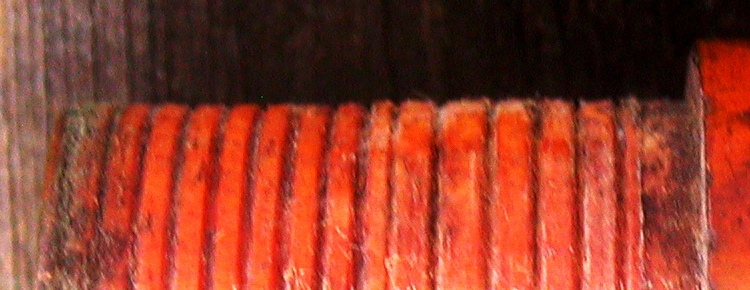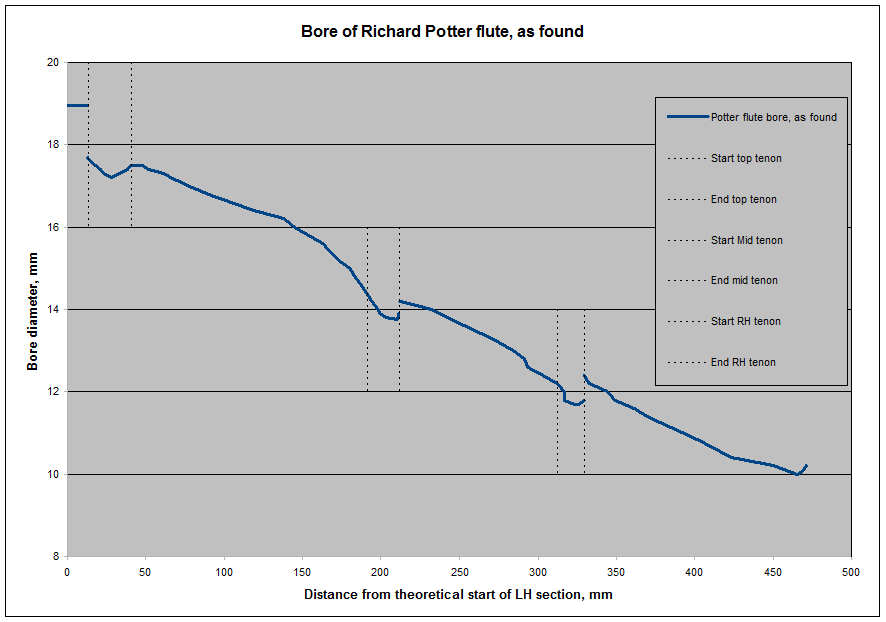|
The seemingly miraculous
recovery of our strangled boxwood test tenon
in "Effects of thread wrapping, Series 1" gave us some hope that a
bore-compressed flute, once liberated from its bindings and subjected to
deep humidity cycling, might spontaneously gravitate back towards its
original shape. But it's one thing for a freshly-strangled,
lightly-made tenon to achieve immediate and spontaneous recovery, and
entirely another for a more heavily-built flute that might have been in
that contorted shape for 100 years or more. With the findings of
our survey that most old flutes show significant level of bore
compression, and that the level of compression is enough for the flute
to be operating outside the realms intended by its maker, demand for
returning flutes from near-death experience is bound to rise.
Restorers and owners need to know what's possible and what's not.
This experiment is intended to explore that void.
What's different in this
experiment?
Surely the test tenons, and
the restoration of the strangled cocuswood and boxwood flutes has
confirmed that threads strangle flutes, and that we can detect and cure
strangulation, restoring strangled flutes to good health. Why do we need
another experiment?
There are a number of
reasons:
-
Firstly, the cocus and
boxwood strangulation victims were other peoples' flutes, sent to me
for repair. There's a limit to the amount of experimentation
you can apply to other people or their flutes without losing
friends! Dr Mengele would be remembered more fondly today if
he had kept that in mind.
-
There's also somewhat of a
time limit. Customers are going to want their flutes back,
preferably within their lifetime. So unreasonable! Don't
they realise I have work to do here?!
-
Those two flutes were
dramatically strangled, while our survey suggests most old flutes are in
the moderately strangled category. What's needed for seriously
strangled flutes might be overkill (pardon the expression) for flutes at
more typical strangulation levels. We want to try coax, before
push comes to shove.
-
The test tenon was deliberately
lightly made, in order to speed up humidity cycling times and produce
meaningful results without waiting for years. It also was just a
tenon, not a tenon connected to a flute. We need now to see what a flute
of more typical dimensions will do, and how long it takes to do it.
-
With a graded series of
restoration options, we could get a chance to test the self-cure hypothesis
raised in the test tenon investigation.
-
Should self-cure work, it offers the
hope of finding out what the original bore might have looked like. If it
doesn't, we will have to find an answer to that conundrum ourselves. Bring
it on!
-
We focussed on upper tenons so far,
but old flutes have two or three tenons, equally capable of being strangled.
Here's our chance to consider the lower tenons as well.
-
And, as in any experiment, we might
learn all sorts of interesting new things along the way.
Meet the victim, er, honoured guest
...
Fortunately, our experiment
has a prospective subject. The Richard Potter flute included in
the survey is a total basket case at the moment, having lost many keys,
blocks and ivory rings. It's on my long-term list to try to save, but
has no immediate prospects, baring perhaps intercession by Australia's
newly canonised St Mary McKillop, or submitting to risky and unproven
scientific experiments. Looks like the latter option is coming up
first....
As you can see, this flute
has seen better times. It came to me as part of a trade from
Canada where it had laid around for years unused. You can see why.

It's Richard Potter's Patent Flute
(you can just make out the word PATENT on the ivory band on the head). He
took the patent out in 1785, featuring these innovations:
-
metal valves, or as we have come
to call them, "pewter plugs", on all keys
-
a metal tuning slide, with
calibrations on the wood covered barrel slide
-
a moveable stopper with calibrations
to match those on the tuning slide
-
an adjustable foot register (but only applicable
to flutes with Short D feet)
This last feature is not applicable
to our guest flute, as it has the C foot. Well, C# foot as it stands at
the moment! As you can see, the stopper with its cap and calibrated
indicator rod is missing too, replaced by a chunk of crudely carved cork.
I do have the G# key, but the upper c key, Bb key and long F key are missing, as
is the hinge block for the upper c key. The spring on the Short F is
broken, and two ivory rings are gone. And there is a bit of a crack in the
barrel, as you can see. "Would suit student." "Ideal for the home
handyman".
This flute will certainly
suit our purposes. It's old enough to be of interest to early
music enthusiasts, and recent enough to interest Irish flute players.
I'll admit to a certain affection and
reverence for Richard Potter. While there were many, many makers in
London, he was one of the much smaller number of innovators. I'd like to
find out what his flute really felt like to play. Heh heh, I might
be the first in over 150 years!
Eeek, an excision!
The first thing to note is
that the flute has been modified. This escaped my attention at
first, as I was concentrating so much on compression in the top tenon, I
didn't pay much attention to the rest of the section. I took the
strange change in combing halfway through the tenon as a sign of
distortion caused by strangulation - it had some points of similarity
with the tenon on the strangled cocuswood flute. But, when I
started measuring the instrument up, I realised the LH section was
unusually short for a flute of this era. Comparing it with the
same section of a flute by his son, William Henry Potter, all became
clear. About 13mm has been taken off the front end of the LH
section! The change in combing style is actually where the old
combing ends.

Who would have done such a
thing? We need to look no further than the middle to late 19th
century. This is about when high pitch came in, soaring to
452-455Hz. (By comparison, Richard Potter back in 1785 might have
expected something around 425Hz.) This is quite interesting, as it
suggests that this flute was still in use then, well into the post-Boehm
period, and 50 to 100 turbulent years after it was built. Almost
assuredly a student or amateur's flute.
You might think I was
downcast to discover this, as it reduces the value of the instrument as
a period piece, and complicates our quest to understand what might have
happened to it. But it's exciting too - I'd heard of flutes being
shortened, and now I have one. We'll want to work out exactly why
they shortened it this much, and how hard it was to play at that
artificially elevated pitch. We'll also wonder if that was the
best solution for their situation. I predicted further up that we
might learn a few more interesting things along the way, and its started
already! And, although it complicates our quest, it certainly isn't a
killer blow. We just have to be a little more careful in our
assumptions and calculations.
While we are there though,
the nature of the shortening bears some interest for us in our primary
quest. To clarify, 13mm (half an inch) has been taken off the
front of the section, which would have extended by this much to the left
of the image above. The combing on the left-hand side of picture
is what remains of the original combing. That to the right of
centre is new, turned down from the full body diameter. Note that
the person who did the shortening, and therefore the new combing, chose
to leave the new section of tenon a slightly larger diameter than the
old section had become. In other words, the tenon had probably
already started to collapse by the time of the shortening, in the second
half 19th century. Further, the shortener was possibly aware of
it, or he might have been tempted to blend the new work in better with
the old. Instead, he probably wisely left the new section of tenon
as large as would fit in the socket. Although we do have to allow
that he might not have been aware of the bore compression and simply
wanted the tenon to fit more snugly than the already compressed tenon
did.
The bore
The bore graph below confirms what sad
condition the poor Potter has fallen into. Let's take a look...
-
The thick blue trace shows us
the bore of the flute body and foot. Normally, I would show such a
diagram starting at the top of the LH section. But, remembering the
13mm excision, I've shown it bumped to the right by 13mm to remind us of
where the cone originally started.
-
The first 13mm is thus shown with
the diameter of the head. Being Potter's Patent flute, it has a
tuning slide, meaning that the bore is lined in metal, and can be trusted to
be essentially the same as when it was made. At least we have one reliable
point of reference!
-
The thin vertical dashed lines indicate where the tenons (and therefore the
relevant sockets on the mating sections) lie. And the compressions
caused by the thread bands in the three tenons are exceedingly obvious, peaking at
around X = 26mm, X = 200mm and X = 320.
(You'll possibly find your
browser's Zoom facility of some value if you want to examine the bumps
and grinds in the graph a little more closely. Usually found under
View.)

Remember I had mentioned, in the previous
series of articles, that we had so far only focussed on LH top tenons.
Look at the two lower tenons on the graph above. They are as distorted as
the top tenon! As the location of each compression will affect a different
set of notes, we can certainly expect the flute's intonation to be different to
when original. Unless we are really lucky and they all miraculously cancel
out! Blessed Mary McKillop, I seek your intercession in a technical matter
pertaining to a particular flute....
And, remember our excision,
carried out in the second half 19th century. Even though
compression had already set in when the tenon was "moved down the flute"
by 13mm, the current compression is still centred on the new tenon
location. Serial strangulation at work!
Conclusions so far.
Well, we embark on a new
adventure, quite different to Series 1. Now we're dealing with a
real flute, and quite a well-known one. And we're dealing with real life
distortions. And, in the form of the 13mm excision, some real-life
tampering. While there may have been some scope for denial and
quibbling in Series 1, we're now facing cold hard reality. What
are we gunna do?
In our next article, already
well advanced, we'll speculate on what the bore might have looked like
originally, and examine the evidence for the competing possibilities.
After that, we'll formulate a plan for dealing with the problem. I
hope you'll join me for the ride.
On to Original Bore Shape, or
Back to McGee-flutes
Index page...
Created 5 April 2011
|